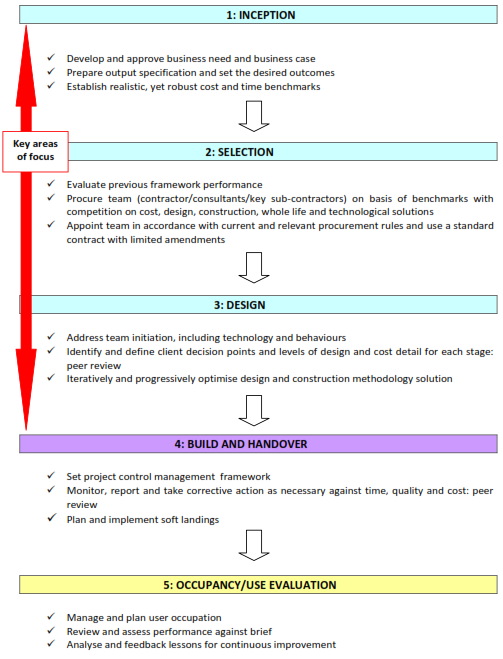Cost led procurement
Contents |
[edit] Introduction
The main aims of the Government Construction Strategy were to ‘change the relationship between Clients and Industry’ and achieve a 15-20% reduction in public sector construction costs by 2015. The Government Construction Task Group report 2012 developed three potential new strategies to help achieve these aims:
- Cost Led Procurement (CLP).
- Integrated Project Insurance (IPI).
- Two Stage Open Book.
All three involve early contractor involvement, transparency and integration. Along with a reduction in costs, they are expected to contribute to a reduction in project risk, improved programme accuracy and an enhanced working relationship between client and the supply chain.
[edit] Background
The Cost Led Procurement method is ‘...intended to allow industry to use its experience and knowledge to develop innovative solutions through leveraging design, materials, subcontracting, direct labour and experience to the advantage of the Public Sector Client...focused on achieving target costs whilst maintaining, if not improving value’ (Cabinet Office, 2014).
In Cost Led Procurement, the project details are clearly identified and a ceiling cost calculated. Typically, an integrated supply team (one or more) is identified through a framework agreement and the team work together to complete the project at below the ceiling cost. In subsequent similar projects within a framework, Cost Led Procurement offers the opportunity for further reduction of costs.
The project is offered to suppliers outside the framework if none of the existing teams are able to deliver the project below the ceiling cost.
[edit] Structure
The CLP plan involves five phases:
- Inception.
- Selection of contractor.
- Design and cost development.
- Construction.
- Operation
The flow chart from the 2014 Cabinet Office publication, Cost Led Procurement Guidance outlines the process.
[edit] Trial projects
Two trial projects were run using the CLP method: Upper Mole and Rye Harbour. The Rye Harbour scheme was successful in achieving a 6% saving through reducing the project programme.
This article contains public sector information licensed under the Open Government Licence v2.0 ref Cabinet Office, Cost Led Procurement Guidance 2014.
[edit] Related articles on Designing Buildings Wiki
- Framework agreement.
- Government construction strategy.
- Integrated project insurance.
- Integrated supply team.
- Managing the procurement process.
- Optimised contractor involvement.
- Procurement route.
- Supply chain.
- Supply chain management.
- Sustainable procurement.
- The benefits of e-procurement in construction.
- Two stage open book.
- Value for money.
[edit] External references
Featured articles and news
Homes England creates largest housing-led site in the North
Successful, 34 hectare land acquisition with the residential allocation now completed.
Scottish apprenticeship training proposals
General support although better accountability and transparency is sought.
The history of building regulations
A story of belated action in response to crisis.
Moisture, fire safety and emerging trends in living walls
How wet is your wall?
Current policy explained and newly published consultation by the UK and Welsh Governments.
British architecture 1919–39. Book review.
Conservation of listed prefabs in Moseley.
Energy industry calls for urgent reform.
Heritage staff wellbeing at work survey.
A five minute introduction.
50th Golden anniversary ECA Edmundson apprentice award
Showcasing the very best electrotechnical and engineering services for half a century.
Welsh government consults on HRBs and reg changes
Seeking feedback on a new regulatory regime and a broad range of issues.
CIOB Client Guide (2nd edition) March 2025
Free download covering statutory dutyholder roles under the Building Safety Act and much more.
Minister quizzed, as responsibility transfers to MHCLG and BSR publishes new building control guidance.
UK environmental regulations reform 2025
Amid wider new approaches to ensure regulators and regulation support growth.
BSRIA Statutory Compliance Inspection Checklist
BG80/2025 now significantly updated to include requirements related to important changes in legislation.























